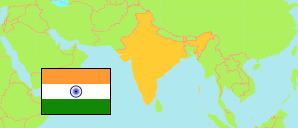
Murshidabad
District in West Bengal State
Contents: Subdivision
The population in Murshidabad as well as related information and services (Wikipedia, Google, images).
| Name | Status | Population Census 2011-03-01 | |
|---|---|---|---|
| Murshidabad | District | 7,103,807 | |
| Beldanga | Municipality | 29,205 | → |
| Beldanga I | Community Development Block | 319,322 | → |
| Beldanga II | Community Development Block | 250,458 | → |
| Berhampore | Community Development Block | 446,887 | → |
| Berhampore | Municipality | 195,223 | → |
| Bhagawangola I | Community Development Block | 202,071 | → |
| Bhagawangola II | Community Development Block | 158,024 | → |
| Bharatpur I | Community Development Block | 172,702 | → |
| Bharatpur II | Community Development Block | 176,368 | → |
| Burwan | Community Development Block | 257,466 | → |
| Dhulian | Municipality | 95,706 | → |
| Domkal | Community Development Block | 363,976 | → |
| Farakka | Community Development Block | 274,111 | → |
| Hariharpara | Community Development Block | 257,571 | → |
| Jalangi | Community Development Block | 252,477 | → |
| Jangipur | Municipality | 88,165 | → |
| Jiaganj-Azimganj | Municipality | 51,790 | → |
| Kandi | Community Development Block | 220,145 | → |
| Kandi | Municipality | 55,632 | → |
| Khargram | Community Development Block | 273,332 | → |
| Lalgola | Community Development Block | 335,831 | → |
| Murshidabad | Municipality | 44,019 | → |
| Murshidabad Jiaganj | Community Development Block | 234,565 | → |
| Nabagram | Community Development Block | 227,586 | → |
| Nawda | Community Development Block | 226,859 | → |
| Raghunathganj I | Community Development Block | 195,627 | → |
| Raghunathganj II | Community Development Block | 265,336 | → |
| Raninagar I | Community Development Block | 189,105 | → |
| Raninagar II | Community Development Block | 190,885 | → |
| Sagardighi | Community Development Block | 310,461 | → |
| Samserganj | Community Development Block | 284,072 | → |
| Suti I | Community Development Block | 179,908 | → |
| Suti II | Community Development Block | 278,922 | → |
| West Bengal | State | 91,276,115 |
Source: Office of the Registrar General and Census Commissioner.
Explanation: States and districts in the boundaries of 2023; subdistricts in the boundaries of 2011. Population figures of new delimitated districts and split subdistricts are mostly computed by using subdistricts or villages in the boundaries of 2011. Thus, slight deviatiations from the actual population are possible in some cases. Area figures are mostly derived from geospatial data.
Further information about the population structure:
| Gender (C 2011) | |
|---|---|
| males | 3,627,564 |
| females | 3,476,243 |
| Urbanization (C 2011) | |
|---|---|
| rural | 5,703,115 |
| urban | 1,400,692 |
| Population Group (C 2011) | |
|---|---|
| »Scheduled Castes« | 897,534 |
| »Scheduled Tribes« | 91,035 |
| not indigenous | 6,115,238 |
| Literacy (A7+) (C 2011) | |
|---|---|
| yes | 4,055,834 |
| no | 2,034,581 |
| Age Groups (C 2011) | |
|---|---|
| 0-6 years | 1,013,392 |
| 7+ years | 6,090,415 |